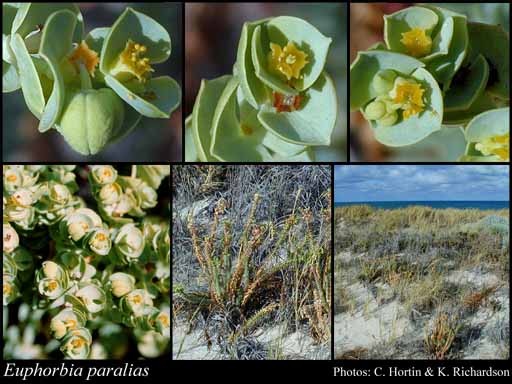- Reference
- Sp.Pl. [Linnaeus] 1:458 (1753)
- Conservation Code
- Not threatened
- Naturalised Status
- Alien to Western Australia
- Name Status
- Current
Erect, bushy perennial, herb or shrub, 0.2-0.6 m high. Fl. yellow-green, Oct to Dec or Jan to Jun. White beach sand. Coastal areas, dunes.

Distribution
- IBRA Regions
- Esperance Plains, Hampton, Jarrah Forest, Mallee, Swan Coastal Plain, Warren.
- IBRA Subregions
- Eastern Mallee, Fitzgerald, Hampton, Perth, Recherche, Southern Jarrah Forest, Warren.
- IMCRA Regions
- Eucla, Leeuwin-Naturaliste, WA South Coast.
- Local Government Areas (LGAs)
- Albany, Augusta Margaret River, Bunbury, Busselton, Capel, Cockburn, Dardanup, Denmark, Dundas, Esperance, Fremantle, Gingin, Harvey, Jerramungup, Mandurah, Manjimup, Perth, Ravensthorpe, Rockingham, Stirling, Wanneroo.
Management Notes (for the Swan NRM Region)
General Biology. Growth form. Herb. Life form. Perennial. Reproduction. Primarily seed, also root fragments. Dispersal. Explosive dehiscing, water, sand, wind, boats, ship ballast. Toxicity. Sap in the leaves and stem is irritant and posionous. Seedbank persistence. 2+ years in salt water, otherwise at least 7 years. Fire response. Likely to recover and resprout.
Notes. Rapidly spreading along the Western Australian coast. Also found throughout coastal southeastern Australia, including Tasmania and the islands off Bass Strait and southern New South Wales. Grows on beach fronts, from the high water mark into dunes, where it colonises bare sand and native dune vegetation. Also found on rocky foreshores, steep back dunes and mouths of coastal lakes and estuaries. Produces large numbers of bouyant salt-tolerant seeds which survive a number of years dispersed on ocean currents. Spreads rapidly once established. Believed to have a significant influence on ecological processes by altering landform morphology, reducing floral and structural diversity, and degrading fauna habitat. Can disrupt many native species including shorebirds that use open sand spits for nesting. Side branches may form anywhere along stems giving it the capacity to grow through accumulating sand. Anchored by a deep taproot with several lateral roots. Flowering is thought to be more dependant on growing conditions than time of year. Annual seed production may be over 20,000 seeds per plant, although this is variable with severely stressed plants producing few, if any, seeds. Above ground stems die after flowering and are replaced by new stems, can recover from damage to the above ground stems from fire, frost, burial or grazing.
Additional information. Origin. Mediterranean. History of use/introduction. Most likely introduced in ship ballasts or by boat. Similar exotic species. Euphorbia helioscopia, E. terracina.
Suggested method of management and control. Hand remove small isolated infestations, ensuring use of appropriate personal protective equipment and safety guidelines. When actively growing, spray with 50 mL glyphosate (360 g/L) + 0.2 g metsulfuron + Pulse® in 10 L water. Consider possible dune erosion. Read the manufacturers' labels and material safety data sheets before using herbicides. For further information consult the Australian Pesticides and Veterinary Medicines Authority to determine the status of permits for your situation or state.
Management Calendar
| Calendar Type | Jan | Feb | Mar | Apr | May | Jun | Jul | Aug | Sep | Oct | Nov | Dec | Comments |
|---|---|---|---|---|---|---|---|---|---|---|---|---|---|
| Active Growth | Y | Y | Y | Y | Y | ||||||||
| Flowering | Y | Y | Y | Y | Y | Y | Y | Y | Y | ||||
| Fruiting | Y | Y | Y | Y | Y | Y | Y | ||||||
| Germination | Y | Y | Y | Y | Y | Y | |||||||
| Manual Removal | Y | Y | Y | Y | Y | Y | Y | Y | Y | Y | Y | Y | Follow safety guidelines |
| Herbicide Treatment | Y | Y | Y | Y | Y |
Legend: Y = Yes, regularly, O = Occasionally, U = Uncertain, referred by others but not confirmed.
References
- Anon. (2009) NSW Weeds: Sea spurge - Euphorbia paralias. Environment, Climate Change and Water, NSW Government URL: http://www.environment.nsw.gov.au/pestsweeds/SeaSpurge.htm.
- Blood, K. (2001) Environmental weeds: a field guide for SE Australia. C.H. Jerram and Associates, Melbourne.
- Brown, K. & Brooks, K. (2002) Bushland Weeds: A Practical Guide to their Management. Environmental Weeds Action Network, Greenwood.
- Elhaak, M.A., Migahid, M.M. & Wegmann, K. (1997) Ecophysiological studies on Euphorbia paralias under soil salinity and sea water spray treatments. Journal of Arid Environments, 35 (3): 459-471.
- Heyligers, P.C. (1989) Sea spurge Euphorbia paralias new record - a strandline pioneer new to the Perth region Western Australia. Western Australian Naturalist, 18 (1): 1-6.
- Heyligers, P.C. (2002) Euphorbia paralias along the south-eastern coast of mainland Australia. Cunninghamia, 7 (3).
- Hussey, B.M.J., Keighery, G.J., Dodd, J., Lloyd, S.G. & Cousens, R.D. (2007) Western Weeds. A guide to the weeds of Western Australia. 2nd Edition. The Plant Protection Society of Western Australia, Victoria Park.
- Keighery, G.J. & Dodd, J. (1997) Occurrence and spread of sea spurge (Euphorbia paralias) along the west coast of Western Australia. Nuytsia, 11 (2): 285-286.
- Moore, J.H. & Wheeler, J. (2008) Southern weeds and their control. DAFWA Bulletin 4744.
- Parsons, W.T. & Cuthbertson, E.G. (2001) Noxious weeds of Australia. 2nd Edition. CSIRO Publishing, Collingwood.
- USDA, ARS, National Genetic Resources Program (2009) Germplasm Resources Information Network - (GRIN). National Germplasm Resources Laboratory, Beltsville, Maryland. URL: https://npgsweb.ars-grin.gov/gringlobal/taxon/taxonomysimple.aspx - Accessed October 2009.
- Wilcock, P.J. (1997) Aspects of the ecology of Euphorbia paralias L. (Sea Spurge) in Australia. University of Ballarat, Ballarat, Victoria. Bachelor of Applied Science Honours Thesis. Centre for Environmental Management, University of Ballarat.
- Wilcock, P.J. & Westbrooke, M.E. (1999) Aspects of the ecology and control of Euphorbia paralias L. (Sea Spurge) in the Otway National Park, Victoria, Australia. In Proceedings of the 12th Australian Weeds Conference, Hobart (eds. A.C. Bishop, M. Boersma & C.D. Barnes) . Tasmanian Weed Society, Davenport.